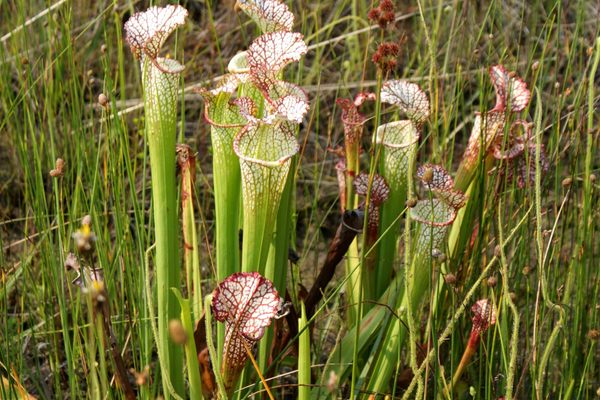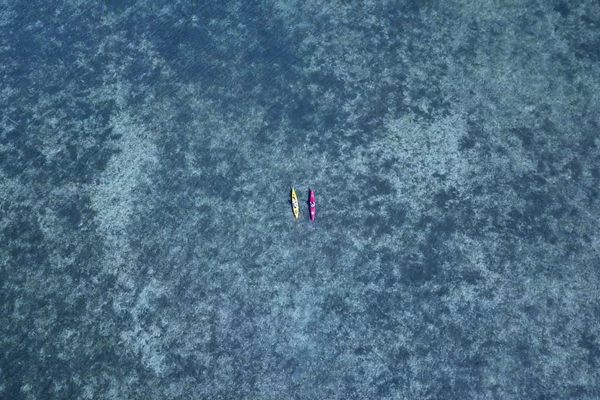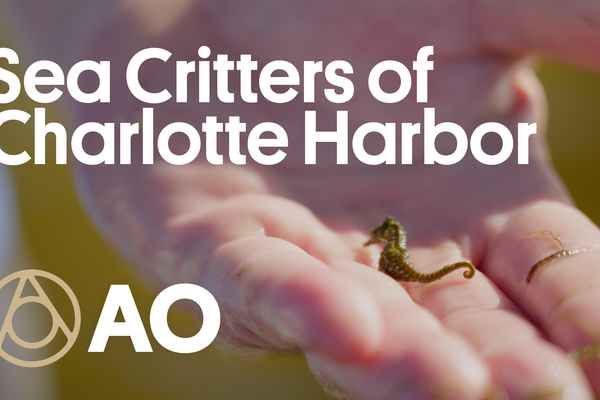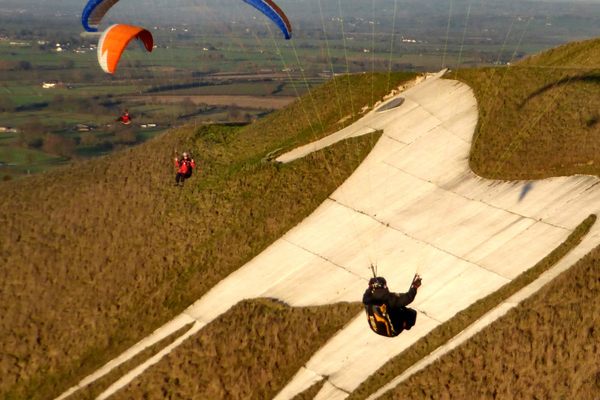
A Field Guide to Exploring Florida’s Best Birding Spots
Discover the feathered residents that are only found in the Sunshine State.
Whether you’re out for a serene stroll or hoping to spot a rare species, Florida offers dozens of peaceful natural havens for bird and wildlife viewing. Have your field guide and binoculars at the ready to identify the elusive Reddish Egret, Snail Kite, or Red-cockaded Woodpecker while also spotting local favorites such as herons, ibis, and storks.
“Birding doesn’t have to be complicated, high tech, or expert,” says Julie Wraithmell, executive director of Audubon Florida, a leading conservation organization focused on birds with 45 grassroots chapters around the state. “It starts simply as the appreciation of birds in nature and a curiosity to learn more. It’s that driving curiosity that makes for the very best birders.”
The state boasts impressive diversity in its avian residents and visitors (Florida’s an important stop for migratory birds), and while some of them need to be carefully searched out, many are easy to spot. “We are known for our birds,” Wraithmell says. “I think it’s only natural that when people end up in Florida, they can’t help but become bird watchers, because it is spectacular and flamboyant.”
Curious to begin your birding journey? Here are some helpful things to know before you go.
There’s an app for that
Audubon has a free birding app that can be used as a field guide with 820-plus detailed species profiles and more than 3,000 bird photos. Birding app Merlin is a favorite for identifying birds by their calls. Just be sure you’re using birdsong apps responsibly: Don’t use recorded playback to lure birds into view, as it disturbs these new feathered friends.
Wish list birds
If you’re hoping to document the birds you see, download a comprehensive checklist courtesy of the Florida Fish and Wildlife Conservation Commission. It lists more than 500 native and naturally occurring stray species that have been recorded in the state, with a place to note when and where you observe them.
Gear up
“The beauty is that a lot of Florida birds are big and showy, and you can observe them with the naked eye,” Wraithmell says. Still, if you decide you want to invest in some gear, basic binoculars are a good place to start. “Birding doesn’t have to be expensive and, yes, you can share binoculars. That’s half the fun,” she says.
No crowding
Wraithmell’s number one tip for responsible birding? Don’t get too close. “The temptation is always there to get a better view,” she says. “But the best birding experience is when the bird’s behavior isn’t modified by you.”
Time your trip
“I subscribe to Florida exceptionalism, and I will tell you: It is always good birding in Florida,” Wraithmell says, as each season offers unique avian attractions. The state sees the most birds in the winter, thanks to migratory birds seeking warmer temperatures.
Here are some of the must-visit spots for your birdwatching bucket list.
1. Snake Bight Trail in Everglades National Park
That’s not a typo, and the snakes aren’t out to get you. A bay within a bay is the definition of a bight, and in the case of Snake Bight, it’s a gradual bend in the shoreline of Florida Bay. This short trail (1.8 miles one way) through a tunnel of mangrove forest rewards nature lovers with scurrying lizards, snakes, and crabs, as well as alligators (in the canal beside the trail) and marshes and mudflats teeming with birds that winter here. Come at high tide for the best views of shorebirds and pause on the scenic boardwalk at trail’s end to look for the rare Reddish Egret, along with herons, ibis, and storks. You might also spot the distinctive pink-and-white plumage of a wading Roseate Spoonbill. Wait to see it in flight, when it reveals its impressive four-foot wingspan. While you’re looking up, don’t miss the ospreys, Peregrine Falcons, and Bald Eagles circling the sky in search of their next meal.
Looking for a shorter excursion? Head to Everglades’ accessible Anhinga Trail, fully paved or with a boardwalk, for practically guaranteed sightings of anhingas, herons, egrets, and more. “It’s a great way to ease visitors into the Everglades,” says Wraithmell.
2. Corkscrew Swamp Sanctuary
Although you might come to this 13,000-acre watershed site for the Wood Storks or Painted Buntings, prepare to spend some time exploring the multitude of other wild wonders along the roughly two-mile boardwalk. Under the shady canopy of 500-year-old towering bald cypress trees, you can listen for the distinct tones of Pileated Woodpeckers, scan for roosting Barred Owls, or watch a Great Blue Heron stalk its prey. A special section of boardwalk around a Wood Stork rookery is a rare treat during breeding season. In its more than 70-year history, this sanctuary has faced constant conservation challenges but continues to provide easy access and educate guests with a kid-friendly visitor center, welcoming naturalists, and a roster of special programs. Bonus: You can rent binoculars on-site if you forget your own.

3. St. Marks National Wildlife Refuge
When the executive director of the state’s Audubon Society declares a spot “a personal favorite,” you know it’s a winner. Plus, adds Wraithmell, St. Marks National Wildlife Refuge “is fairly beginner-friendly,” meaning it’s easy to spot spectacular avian life. For nearly 100 years, it has provided winter habitat for migratory birds along a roughly 40-mile stretch of coastline in northwest Florida—including the recently protected Smith’s Island, seasonal home to an estimated 1,500 nests. Multiple trails and brackish pools give visitors a variety of vantage points for watching waterbirds, songbirds, and raptors. Head to the famous St. Marks Lighthouse to see thousands of overwintering ducks, from Northern Shovelers to Redheads, and you might also spot Belted Kingfishers, Double-crested Cormorants, Roseate Spoonbills, and both White and Brown Pelicans. High above, Bald Eagles and Northern Harriers ride the thermals over wildflower meadows and floating bands of Bufflehead sea ducks.
4. Wakodahatchee Wetlands Park
Wakodahatchee Wetlands Park exemplifies how wetlands can be a win-win. “They were built for an environmental purpose and have ended up becoming a tremendous ecotourism amenity,” Wraithmell explains. This 50-acre park, built to filter wastewater in Delray Beach, draws more than 178 avian species, in addition to frogs, turtles, alligators, and an array of fish. Thanks to its abundant winged residents, Wraithmell says, the park is a “low-effort bird watching area,” meaning you don’t have to be an expert to enjoy the view. Free to visit, it has a three-quarter-mile boardwalk that spans open water areas as well as small islands for nesting and roosting birds. The park is part of the South Section of the Great Florida Birding Trail and is known to be a favorite of bird photographers because of the almost guaranteed sightings of Purple Gallinules, Least Bitterns, Limpkins, Black-bellied Whistling-ducks, and more. Come from February to April for a chance to spot Wood Storks nesting in the park’s abundant Pond Apple trees.

5. Kissimmee Prairie Preserve State Park
Seemingly infinite expanses of blue skies and waving grassland mark this 54,000-acre preserve that protects Florida’s largest remaining area of dry prairie. Kissimmee Prairie Preserve State Park, part of the Everglades headwaters, is home to six federally threatened and endangered species, as well as a diverse collection of other winged residents, a fact that draws nature photographers and birders alike. Because of its remote location and abundant grasslands in which birds may be camouflaged, Wraithmell says it’s best to expect to do some “birding by ear” to locate top highlights such as burrowing owls, the Florida Grasshopper Sparrow, Crested Caracaras, wood storks, and Swallow-tailed Kites. This location would be ideal to try a birdsong app to identify what you’re seeing and hearing.

6. Fort DeSoto Park
If migratory songbirds and coastal birds top your wishlist, Fort DeSoto Park in Pinellas County is an ideal destination. This western central Florida park covers 1,136 acres across five interconnected islands, with miles of sandy shoreline on the Gulf of Mexico. In the 60 years ornithologists have spent actively documenting avian activity here, they have recorded more than 328 species of birds. Depending on the season (and your luck), you might see Heermann’s Gulls, Bananaquits, Elegant Terns, Yellow-green Vireos, Razorbills, and more. 6.

7. Paynes Prairie Preserve State Park
Wildlife lovers of all stripes will find plenty to love at the state’s first preserve, Paynes Prairie Preserve State Park south of Gainesville, where you can see wild horses and bison roaming the prairie. The park’s varied habitats also include marsh, hardwood hammocks, swamps, streams, and lakes. Scale the 50-foot observation tower for a bird’s-eye view of the park or explore any of the park’s eight trails to catch a glimpse of some of the birds on the park checklist, including large numbers of migratory Sandhill cranes in the winter and rare species like Tundra Swans, Golden Eagles, White-faced Ibis, Yellow Rails, and Vermilion Flycatchers. Craving even more eye-popping views? Head to the Sweetwater Wetlands on Paynes Prairie’s northern edge and wander its 3.5 miles of boardwalks and gravel trails where you’re practically guaranteed terrific birdwatching. According to Wraithmell, it’s one of the best places to see Snail Kites, an endangered species of raptor.
Sponsored by VISIT FLORIDA.

































Follow us on Twitter to get the latest on the world's hidden wonders.
Like us on Facebook to get the latest on the world's hidden wonders.
Follow us on Twitter Like us on Facebook